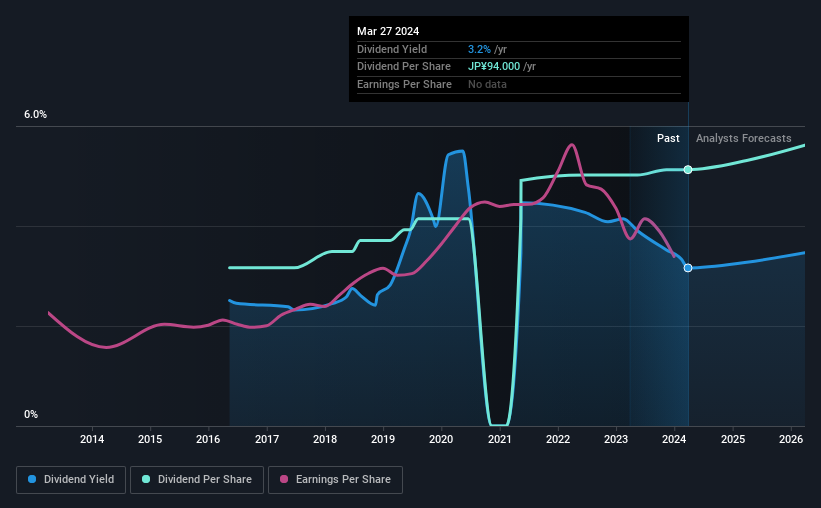
Japan Post Insurance Co., Ltd. (TSE:7181) will pay a dividend of ¥47.00 on the 20th of June. Based on this payment, the dividend yield for the company will be 3.2%, which is fairly typical for the industry.
Check out our latest analysis for Japan Post Insurance
Japan Post Insurance's Payment Has Solid Earnings Coverage
While it is always good to see a solid dividend yield, we should also consider whether the payment is feasible. Before making this announcement, Japan Post Insurance was earning enough to cover the dividend, but it wasn't generating any free cash flows. No cash flows could definitely make returning cash to shareholders difficult, or at least mean the balance sheet will come under pressure.
The next year is set to see EPS grow by 7.4%. If the dividend continues on this path, the payout ratio could be 42% by next year, which we think can be pretty sustainable going forward.

Japan Post Insurance's Dividend Has Lacked Consistency
Japan Post Insurance has been paying dividends for a while, but the track record isn't stellar. Due to this, we are a little bit cautious about the dividend consistency over a full economic cycle. Since 2016, the annual payment back then was ¥58.00, compared to the most recent full-year payment of ¥94.00. This implies that the company grew its distributions at a yearly rate of about 6.2% over that duration. We like to see dividends have grown at a reasonable rate, but with at least one substantial cut in the payments, we're not certain this dividend stock would be ideal for someone intending to live on the income.
Japan Post Insurance May Find It Hard To Grow The Dividend
With a relatively unstable dividend, it's even more important to evaluate if earnings per share is growing, which could point to a growing dividend in the future. Although it's important to note that Japan Post Insurance's earnings per share has basically not grown from where it was five years ago, which could erode the purchasing power of the dividend over time. Growth of 1.5% may indicate that the company has limited investment opportunity so it is returning its earnings to shareholders instead. This isn't bad in itself, but unless earnings growth pick up we wouldn't expect dividends to grow either.
Our Thoughts On Japan Post Insurance's Dividend
Overall, we always like to see the dividend being raised, but we don't think Japan Post Insurance will make a great income stock. While the low payout ratio is a redeeming feature, this is offset by the minimal cash to cover the payments. This company is not in the top tier of income providing stocks.
Market movements attest to how highly valued a consistent dividend policy is compared to one which is more unpredictable. At the same time, there are other factors our readers should be conscious of before pouring capital into a stock. To that end, Japan Post Insurance has 3 warning signs (and 1 which is a bit unpleasant) we think you should know about. Is Japan Post Insurance not quite the opportunity you were looking for? Why not check out our selection of top dividend stocks.
New: Manage All Your Stock Portfolios in One Place
We've created the ultimate portfolio companion for stock investors, and it's free.
• Connect an unlimited number of Portfolios and see your total in one currency
• Be alerted to new Warning Signs or Risks via email or mobile
• Track the Fair Value of your stocks
Have feedback on this article? Concerned about the content? Get in touch with us directly. Alternatively, email editorial-team (at) simplywallst.com.
This article by Simply Wall St is general in nature. We provide commentary based on historical data and analyst forecasts only using an unbiased methodology and our articles are not intended to be financial advice. It does not constitute a recommendation to buy or sell any stock, and does not take account of your objectives, or your financial situation. We aim to bring you long-term focused analysis driven by fundamental data. Note that our analysis may not factor in the latest price-sensitive company announcements or qualitative material. Simply Wall St has no position in any stocks mentioned.
About TSE:7181
Japan Post Insurance
Provides life insurance products and services in Japan.
Slight and fair value.
Similar Companies
Market Insights
Community Narratives



